How to connect an Internet outlet: a step-by-step installation guide
You have a need to install a special outlet for connecting to the Internet, but do not want to call the wizard? Agree that independent installation will save money, and you will be sure of the quality of work performed.
But you do not know how to connect an Internet outlet and what will be required for this? We will tell you where to start - this article will explain in detail the features of the connection to the home foreman and civil engineer, as well as give comprehensive answers to all related questions.
Visual photos and useful videos will help you understand the installation process and tell you what you need to focus on when connecting RJ-45 female connectors.
The content of the article:
The need to install an outlet
Most of us live in multi-room apartments and private houses. For each separate room of such dwellings, it is necessary to solve one small but rather “insidious” problem: in any available way, create a “point” for connecting to the Internet devices of different types of connection.
It would seem that the answer is obvious - to buy and install a Wi-Fi router and there are no problems. But here are some people, to put it mildly, not enthusiastic about the negative influence of electromagnetic waves from medium- and low-power generators on their own health, the health of their loved ones and especially young children.
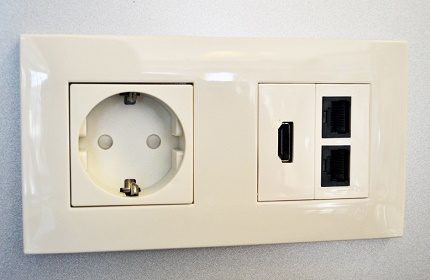
Therefore, it is worth thinking about reducing the electromagnetic “smog” in our homes and apartments.
One of these methods is to install with the connection of Internet outlets directly in the walls of the room.
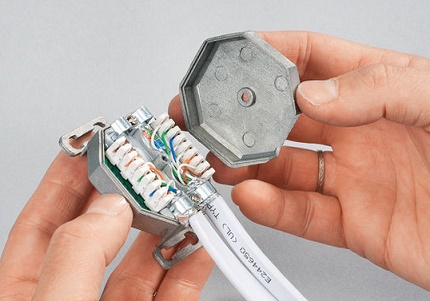
You need to understand that this is only one of the options for providing multi-point Internet access for laptops, stationary computers, mini-servers and personal data storage in your home / apartment / office.
The process of connecting the outlet with your own hands is shown in the form of step-by-step photo instructions below.
Options for using Internet outlets
In addition to “home” use projects, there are still a sufficient number of options.
In which the installation of such outlets for the Internet will be not only relevant, but sometimes just an original way out of a special, demanding security situation, taking into account the technical conditions for providing Internet access.
Depending on the type and purpose of the building, technical requirements are put forward for arranging apartments in such buildings.
There are several main categories of such premises:
- Offices, classrooms and server rooms
- Internet clubs and digital libraries;
- IT shops and workshops for the maintenance of computer equipment;
- facilities with increased penetration protection.
For most offices and classrooms, in addition to the availability of wireless Internet access points, it is mandatory to equip the walls and office furniture with RJ-45 sockets, which provide the connection of “work” computer stations to the Internet, as well as to local networks.
None of the server-type premises can do without the presence of twisted pair connectors in / on the walls. This is a mandatory requirement for every IT engineer who has taken up the construction of a “server” or data warehouse.
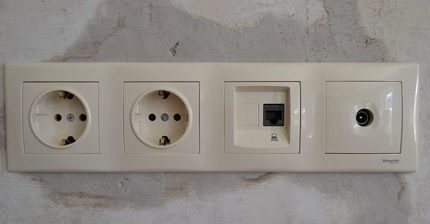
The rapid development of technology affects all aspects of our lives and, in particular, education.
Now it’s very “hard” to imagine an educational institution of any level, from school to university, without the presence of auxiliary search tools (computers). They search and provide the necessary information in a huge “knowledge bank” - an electronic library.
If you are a private entrepreneur or business owner, which is associated with the sale and / or repair of computer and office equipment, then the presence of outlet designs is simply “vital” for the normal working conditions of your employees.
And another example of the mandatory equipment of Internet outlets and constructs - premises for corporate and state security services.
As well as bank and other storages, with increased protection against penetration, where virtually any significant electromagnetic radiation is prohibited or interception of packet information through wireless data transmission is possible.
Types and types of Internet outlets
In order to understand what type of sockets we need to use in a particular case, we need to understand the general classification of sockets under the RJ-45 connector.
But before, the RJ-45 is a unified standard for physically connecting computers and network switches using a standard 8-core shielded wire, often called a twisted pair cable.
Because by making the cross section of the cable, you can easily see 4 intertwined pairs of wires. With this type of wire, the vast majority of information transmission channels in local and public networks are built.
You may also be interested in information about varieties of cable for internet and selection recommendations.
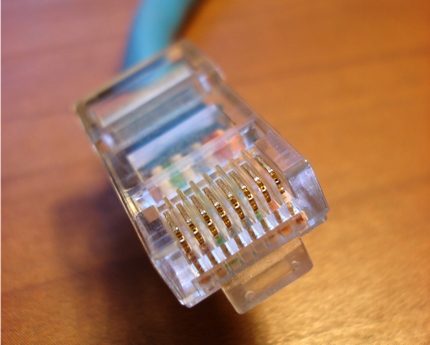
Specialists suggest the following classification of outlets:
- By the number of connectors. Distinguish single, double and terminal sockets with 4-8 connectors. In addition, there is still a separate type of combined outlets. Such modules may contain additional types of interfaces, including audio, USB, HDMI, and RJ-45 itself.
- By data rate. There are many varieties and categories, the most important of which is category 3 - data transfer rates up to 100 Mbit / s, category 5e - up to 1000 Mbit / s and category 6 - up to 10 Gbit / s over a distance of 55 meters.
- According to the principle of fastening. By analogy with power wiring products, there are internal and overhead computer sockets. At the internal outlet, the mechanism (the contact group of the clamps) is deepened into the wall, at the outwardly laid along the surface of the wall.
For a socket of a hidden wiring laid in the wall, it is necessary to have a protective plastic “glass” in the wall, where the terminal block is attached. An external outlet is usually mounted using a patch panel on the wall surface.
As for the manufacturers: there are many, domestic and foreign. Recently, “Chinese” network equipment companies have begun to “level off” in terms of finished product quality relative to the rest.
Uniquely high quality differs products from such global brands as Digitus, Legrand, VIKO, etc.
Separately, it is worth mentioning the “keystones” - keystones.
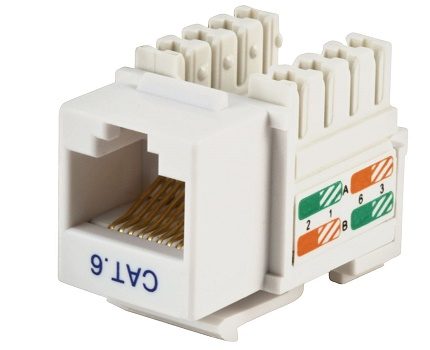
This is a modular architecture for placing individual “stones” - modular connectors for a wide variety of audio, video, telephone, optical, Mini-DIN and other interfaces, including RJ-45 on one standard panel of the socket block.
This is a fairly flexible and scalable system for providing interfaces to the end user.
Laying “twisted pair” on / on the walls
We pass from theory to practice. If we are talking about laying cables and wires in a new building, then no special questions should arise: we put twisted pair next to the rest of the communications, usually in corrugated tubes, and their holes in the cut-out hollows.
Be sure to remember the number of wires inserted into the channel and their average diameter, and also take into account the channel diameter + 25% of the total sum of all cable diameters.
Another thing is if we make repairs in an existing room and re-create the channels. It is necessary to take into account the material of which the walls are made: frame gypsum panels, brick, concrete, etc.
The hardest thing is to make the channels in concrete / brick without damaging the rest of the communications.
To detect wiring in the walls, you can use any available building electromagnetic wiring detectors.
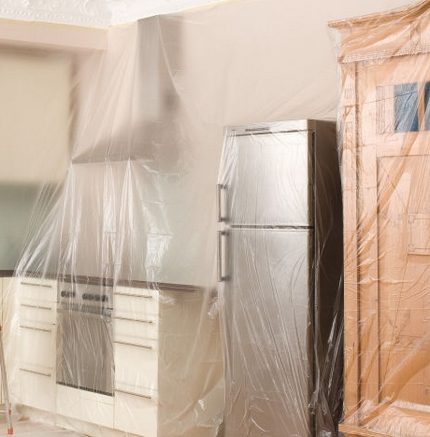
It should be noted that there will be a lot of dust if you work in concrete. As a result of gating with abrasive dust and small pebbles everything that is in the room will be covered: walls, ceiling, floor, furniture, equipment.
Therefore, you must initially free the room or cover everything with plastic wrap.
We strongly recommend that the master wear the following set:
- tight jumpsuit (jacket / pants);
- headdress (you can have a swimming cap, bandana);
- glasses (we recommend skiing or others with protection of the temporal areas of the face);
- thin and comfortable gloves, boots, personal protective equipment for the respiratory tract (face masks, respirators, dressings, etc.).
For gating (forming channels in foam concrete or brick walls), you need to use the following tools: grommets, wall cutters, groove cutters.
As an option, it is still possible to use powerful “grinders” with cutting discs (with diamond coating). The cutting depth of the channel should be 30-35 mm, width up to 25 mm exclusively for one or more twisted-pair wires.
Absolutely all channels and gutters must be done at right angles - this is an obligatory rule of any building repair.
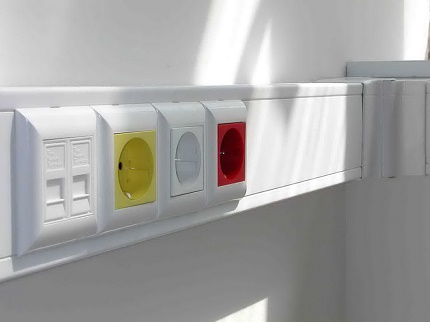
As for the cavities for sockets, they are made using a jumper, an electric hammer or a drill / perforator with a nozzle for a socket hole.
But initially, you need to determine the approximate placement of Internet outlets in the premises. As a rule, holes for RJ45 sockets are drilled at a height of 1000-1200 mm from the floor or 150-300 mm.
For residential premises, one or two outlets on opposite walls of the room are enough. For offices, they usually put one outlet near the future workplace.
In server rooms and similar in function rooms, a different strategy is to make 3-4 holes for modular socket blocks, two blocks on one wall and one on all other walls.
And the last thing you need to pay attention to in terms of laying wires - sometimes it is possible to lay communications under the floor or in the ceiling of the room.
In such a situation, the question of gating walls does not arise, it is enough to bring the wire under the floor or ceiling and put it in the region of the outlet on the wall.
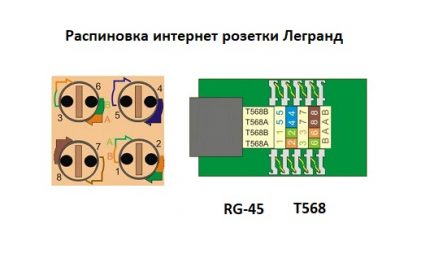
Features cable pinout RJ-45
Before you connect an Internet outlet, you need to clearly know and understand where and what color to mount each individual twisted pair wiring. To do this, you need to know the crimping scheme and the rules. do-it-yourself cable crimping RJ-45.
There are two main types wire pinouts RJ-45: direct and cross. The first type of cable is used to connect end devices (computer / PC, smart TV / Smart TV, switch / Switch) to the so-called router (Router).
The second type of cable is used to connect devices similar in function (computer - computer, router - router, switch - switch) with each other.
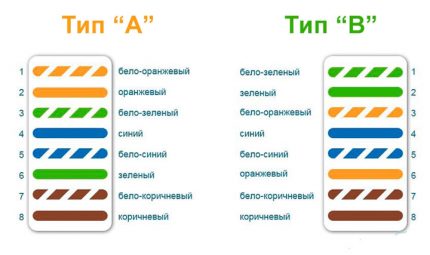
First, we leave about 100-150 mm from the wall plane along the cable length, and cut off the rest of the cable. This length will be enough for possible subsequent wiring.
Before starting electrical work, you can familiarize yourself with twisted pair crimping circuits for 8 and 4 coresconsidered in our other article.
Now you need to free 4 pairs of wires from the outer shell and from the foil (it acts as a protective shielding) if any.
There is also a special thread inside the twisted pair with which you can easily release all the necessary wiring. You can also use a regular knife or a special cutting surface, which is equipped with almost all crimping pliers.
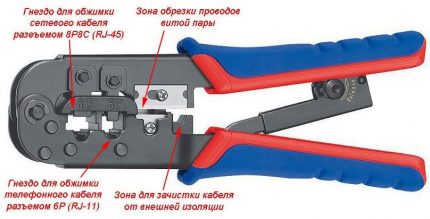
At the next stage, we rectify all twisted pairs of multi-colored wires and carefully “plant” each individual color in its own niche according to the color pinout in the terminal block of the socket.
This must be done in such a way that the rest of the “untouched” insulation wire falls under the terminal block clamp. Now we twist the fixing bolts with a screwdriver on the terminal strip and simultaneously press the remaining wiring so that they do not come out of their seats.
In conclusion, with a “sense of strength”, we press down the screw connectors on the terminal block with a screwdriver and fix each core in the terminal group separately, while cutting through the braid of small wires. After we trim the leftovers. Wiring should be all at the same height from the base of the terminal block.
You may also find useful information about twisted pair extension methods.
Checking Wiring Signals
Separately, it is worth mentioning the possibility of checking the availability, and most importantly, the correctness of the signals passing through 8 wires of a twisted pair cable. This can be done using a conventional electrical tester.
But first, you need a patch cord (ready-to-use wires at both ends of which are mounted, again in a direct pinout diagram, RJ-45 format connectors) and a second unmounted Internet outlet or keystone.
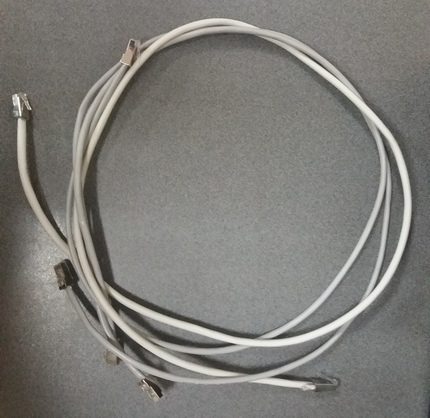
Pre-mount the second end of the laid wire in an unmounted outlet / keystone, into which we insert one end of the patch cord.
We switch the tester to the sound signal mode and compare the corresponding connector channels on the patch cord and in the Internet outlet. We get a sound signal that indicates the presence of a connection.
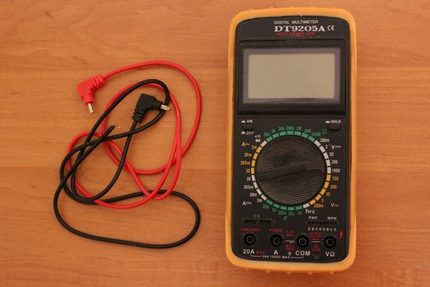
There is also the option of checking signals with the help of special cable testers, but for this you need one more patch cord ready and working according to the direct scheme. We insert one end of each patch into sockets (new and temporary), the other two are inserted into the cable tester.
Light and sound accompaniment on the tester panel indicates the presence or absence of a signal on a particular twisted pair core. We look and check the signal.
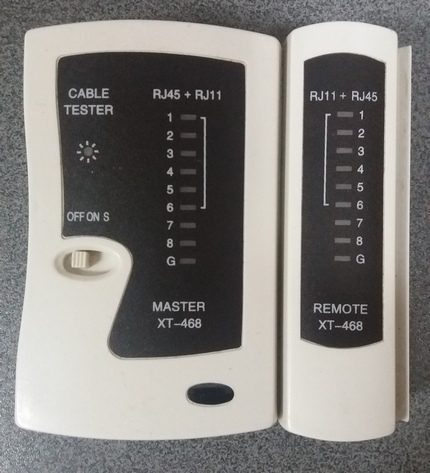
Ideally, we will receive 8 light and sound signals in a cable tester in sequence. In these two ways, you can verify the correct pinout and the presence of a full-fledged signal for transmitting data through a twisted pair cable.
Installing the terminal block and mounting the cover
After checking the signals, we proceed to the final part of the installation of the Internet outlet.
To do this, carefully hide the rest of the wires and return the terminal strip with the cores connected back to the socket, pull the fixing bolts to the mounted “glass”.
The terminal block must “sit” tightly in the socket, there should be no protruding and bent wires.
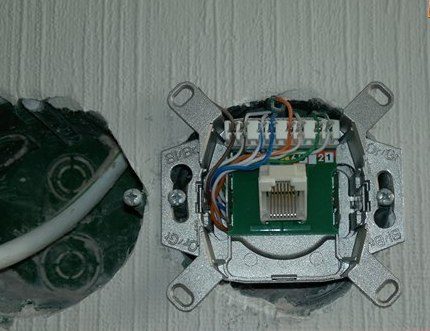
Once again, we check the connection, for this we connect a device, for example, a laptop, and see if it detects a connected local network or the Internet.
If there is no connection on the device, we return to the pinout point and again check the correctness of the actions performed, as well as the quality of the crimping. It often happens that one of the cables is trite in the terminal block. To do this, you just need to tighten the core clamp more tightly.
After an additional check of the network’s operability, we trim all the remains of the protruding veins and proceed to mount the lining. The cover plate is usually equipped with several plastic latches.
It is enough to accurately place it on the socket and press until you hear a click sound. That's it, the Internet outlet is installed and ready for use.
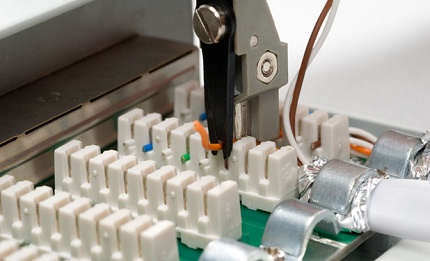
Conclusions and useful video on the topic
A similar instruction can be used to connect and install any kind of Internet outlets:
They may differ in the location of contact groups and a set of interfaces, in the way of mounting, but this does not change the essence of the matter:
Do-it-yourself connection of single or modular Internet outlets is available to any home master, not to mention IT engineers. The main thing is to “guess” the first time with a color pinout of the cores and get a high-quality data signal through a twisted pair.
Have you repeatedly performed electrical work and can supplement the information in our article with practical recommendations? Or did you install such a socket with your own hands and faced an interesting moment that we did not mention here? Please share your tips with our readers - leave comments under this article.

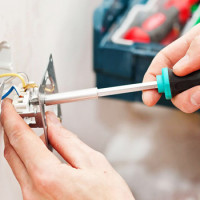 How to install and connect an outlet: a step-by-step guide
How to install and connect an outlet: a step-by-step guide 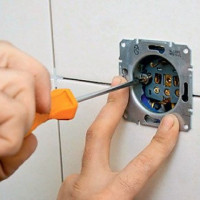 Wiring diagram for a two-gang switch
Wiring diagram for a two-gang switch 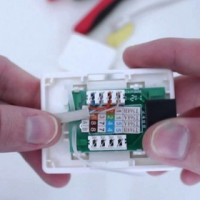 How to connect a telephone socket: connection diagram and installation rules
How to connect a telephone socket: connection diagram and installation rules 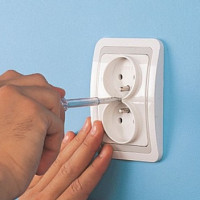 How to connect a double outlet: installing a double outlet in one socket
How to connect a double outlet: installing a double outlet in one socket 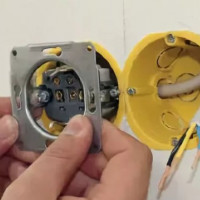 How to install a socket in drywall: installation rules and tips for installing a socket
How to install a socket in drywall: installation rules and tips for installing a socket 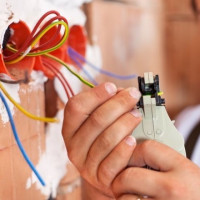 How to install and connect an outlet with grounding: learn to ground the outlet
How to install and connect an outlet with grounding: learn to ground the outlet  How much does it cost to connect gas to a private house: the price of organizing gas supply
How much does it cost to connect gas to a private house: the price of organizing gas supply  The best washing machines with dryer: model rating and customer tips
The best washing machines with dryer: model rating and customer tips  What is the color temperature of light and the nuances of choosing the temperature of the lamps to suit your needs
What is the color temperature of light and the nuances of choosing the temperature of the lamps to suit your needs  Replacement of a geyser in an apartment: replacement paperwork + basic norms and requirements
Replacement of a geyser in an apartment: replacement paperwork + basic norms and requirements
At home, I did the wiring of the Internet cable from just a router to two stationary computers in different rooms.
The article describes the process in great detail, and at first glance, it might seem that this is very difficult. In fact, there is nothing difficult about this. Buy a twisted pair of the desired length and crimping pliers, also do not forget about the required number of plugs. I recommend that you purchase the plugs with a margin, since without experience, you will not be able to squeeze normally for the first 2-3 times.
I took the outlet bill, so as not to hammer the wall. Laying the cable and installing the outlet does not cause difficulties, all the wisdom lies in the correct and high-quality crimping of the cable into the plug.
I took the pinout diagram when connecting computers to the router as type A. Well, look carefully at the colors of the wiring, since the cable has the same color striped wiring and wiring the same color without strips, it is important not to confuse. And then only sleight of hand.
Good day! I would like to supplement your instructions a bit and remind a couple more, it seems to me, of important points.
It is advisable that the total length of the cable from the provider’s equipment to your device in the apartment does not exceed 100 meters, since when the meter exceeds 100+, the signal partially weakens.
It is also important to choose the right cable. If you will lay it in the wall, it is better to take a cable with a copper core. It will last longer and better signal transmits.
Is wi-fi radiation so harmful that it makes it worthwhile to wire across the apartment? I don’t know, I personally use a router, I reduced the power of its transmitter to 20% of the total power, and I work normally.
Generally speaking, it is strange to hear about the dangers of wi-fi when we are constantly in this environment - any cafe, neighbors behind the wall, and it even exists on some buses. Far, as they say, do not hide. But if you really want a wire, then I would choose a method with a cable channel - less labor-intensive and cheaper.
Yes, now you can’t get away from wi-fi networks and it's really stupid to lead a cable through the entire apartment. But there are all sorts of cases. For example, you can pre-take care of such outlets during repairs when laying the main wiring. It will be quite convenient later.
Well, or even professional gamers need a cord so that there is less ping 🙂
Maybe I'm wrong, but the first appeared pinout “cross”, which you have indicated as type “B”. To connect computers directly, even before the advent of local networks, the Internet, routers, routers, etc. And she was designated as type “A”. Faced installing computer sockets ABB Basic. You confused me. Is there a circuit?
As indicated in the comments above, copper cable is more reliable. Mounting twisted pair video surveillance systems (PoE). If the cable is not copper, with a line length of more than 60-70 meters, IP cameras lose signal. Copper holds 100 m. You can check by clearing the core and scraping it with a knife. If turned white - copper-plated. The difference in price is 20-40 rubles / m.
As for the wifi. If you have a two-story cottage or a three-wheeler in a monolithic (panel) house, will a router with three powerful antennas save you? And imagine how it phonites in addition to electromagnetic radiation from electrical wiring. In addition, a new IPBaseT (HDBaseT) protocol has been developed for transmitting 4K video over twisted pair, and not over 4 HDMI cables as it is now. In the future, 8K. All 4 pairs are involved (8 cores), and not 2 as now.
The cable can be laid in a skirting board with a cable channel. Or under the skirting board. When crimping the RJ-45 connector, carefully straighten all the cores and cut them evenly. I mount the systems with a shielded cable (FTP, not UTP). Local networks are not always obtained separately from power cables (especially in office cable channels) and cross them at right angles.
At the expense of pinout of the RJ45 connector by color - everything is quite simple, here the author did not touch on the background, since it would simply not be interesting to many uninitiated in the topic.
Regarding the connection of IP cameras - here I agree with you, only a copper cable. Copper is more practical, more durable and less susceptible to mechanical damage during bending and twisting.
At the expense of routers for two- and three-story houses, it will be more practical to make 2-3 routers on each floor than to put one powerful one.
At the expense of separate laying of network cables from wiring and power cables - yes, this is ideal, but in practice it is far from always possible to adhere to this rule. To avoid additional cable stress from bending at right angles, I do round twists.
Good day to all. I installed an Internet outlet at home according to the “B” scheme; I want to pick up a router for it. Tell me, please, how to crimp both ends of a twisted pair cable between the outlet and the router?
Yak p_dlyuchiti 8 cables?